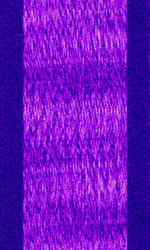Digital Radio Mondiale (DRM)
Digital Radio Mondiale (DRM) is a digital commercial broadcasting mode used to deliver FMFrequency Modulation-comparable sound quality to shortwave radio. DRM is a digital alternative to AMAmplitude Modulation shortwave radio. WinDRM is an amateur adoption of this mode.
DRM uses COFDMCoded Orthogonal Frequency-Division Multiplexing (Coded Orthogonal Frequency Division Multiplexing) with QAMQuadrature Amplitude Modulation (Quadrature Amplitude Modulation).
DRM is commonly seen with 10 kHzKiloHertz (kHz) 10^3 Hz of bandwidth. Other bandwidths are used rarely.
Bandwidths[edit]
DRM is commonly seen with 10 kHzKiloHertz (kHz) 10^3 Hz of bandwidth. Other bandwidths are used rarely.
- 4.5 kHzKiloHertz (kHz) 10^3 Hz. Gives the ability for the broadcaster to do a simulcast and use the lower-sideband area of a 9 kHzKiloHertz (kHz) 10^3 Hz raster channel for AMAmplitude Modulation, with a 4.5 kHzKiloHertz (kHz) 10^3 Hz DRM signal occupying the area traditionally taken by the upper-sideband.[12] However the resulting bit rate and audio quality is not good.
- 5 kHzKiloHertz (kHz) 10^3 Hz. Gives the ability for the broadcaster to do a simulcast and use the lower-sideband area of a 10 kHzKiloHertz (kHz) 10^3 Hz raster channel for AMAmplitude Modulation, with a 5 kHzKiloHertz (kHz) 10^3 Hz DRM signal occupying the area traditionally taken by the upper-sideband. However the resulting bitrate and audio quality is marginal (7.1–16.7 kbit/sKilobits per second (kbps) for 5 kHzKiloHertz (kHz) 10^3 Hz). This technique could be used on the short wave bands throughout the world.
- 9 kHzKiloHertz (kHz) 10^3 Hz. Occupies half the standard bandwidth of a region–1 long wave or medium wave broadcast channel.
- 10 kHzKiloHertz (kHz) 10^3 Hz. Occupies half the standard bandwidth of a region–2 broadcast channel. could be used to simulcast with analogue audio channel restricted to NRSC5. Occupies a full worldwide shortwave broadcast channel (giving 14.8–34.8 kbit/sKilobits per second (kbps))
- 18 kHzKiloHertz (kHz) 10^3 Hz. Occupies full bandwidth of region–1 long wave or medium wave channels according to the existing frequency plan. This offers better audio quality.
- 20 kHzKiloHertz (kHz) 10^3 Hz. Occupies full bandwidth of region–2 or 3 AMAmplitude Modulation channel according to the existing frequency plan. This offers highest audio quality of the DRM30 standard (giving 30.6–72 kbit/sKilobits per second (kbps)).
Modes[edit]
DRM has 4 main modes, from A to D. Different modes are used to accommodate varying propagation conditions.
- A: Gaussian channel with very little multipath propagation and Doppler effect. This profile is suited for local or regional broadcasting.
- B: multipath propagation channel. This mode is suited for medium range transmission. It is nowadays frequently used.
- C: similar to mode B, but with better robustness to Doppler (more carrier spacing). This mode is suited for long distance transmission.
- D: similar to mode B, but with a resistance to large delay spread and Doppler spread. This case exists with adverse propagation conditions on very long distance transmissions. The useful bit rate for this profile is decreased.
| Mode | OFDMOrthogonal Frequency-Division Multiplexing carrier spacing (HzHertz (Hz), unit of frequency, defined as one cycle per second (1 Hz).) | Number of carriers | Symbol length (msmilliseconds (.001 of a second)) | Guard interval length (msmilliseconds (.001 of a second)) | Nb symbols per frame | |||
|---|---|---|---|---|---|---|---|---|
| 9 kHzKiloHertz (kHz) 10^3 Hz | 10 kHzKiloHertz (kHz) 10^3 Hz | 18 kHzKiloHertz (kHz) 10^3 Hz | 20 kHzKiloHertz (kHz) 10^3 Hz | |||||
| A | 41.66 | 204 | 228 | 412 | 460 | 26.66 | 2.66 | 15 |
| B | 46.88 | 182 | 206 | 366 | 410 | 26.66 | 5.33 | 15 |
| C | 68.18 | - | 138 | - | 280 | 20.00 | 5.33 | 20 |
| D | 107.14 | - | 88 | - | 178 | 16.66 | 7.33 | 24 |
Frequencies[edit]
Most DRM broadcasts are found in the shortwave band usually between 1 MHzMegaHertz (MHz) 10^6 Hz to 26 MHzMegaHertz (MHz) 10^6 Hz. A list of DRM broadcasts and times can be found at this Schedule of DRM broadcasts. The only VHFVery High Frequency (30-300 MHz)-based DRM as of 2015 is a 98900 kHzKiloHertz (kHz) 10^3 Hz Slovak broadcast.
Decoding Software[edit]
- Hobby Level Software
Decoding Tutorials[edit]
Video Examples[edit]
- DRM REE Noblejas Radio with RTL SDR (RTL2832), Nooelec Ham It Up Upconverter, SDR Sharp and DREAM
- DRM vs AM Radio NZ with RTL SDR (RTL2832), Nooelec Ham it up upconverter, DREAM and SDR Sharp
- Decoding DRM (Digital Radio Mondiale)
- Radio New Zealand International DRM Broadcast
See Also[edit]
Additional Links[edit]
Samples[edit]
- DRM AF 9kHz mode B (uses xHE-AAC, codec needed for decode)
- Media:Opus_Codec_Test_Mode_A_20kHz_V2.wav



